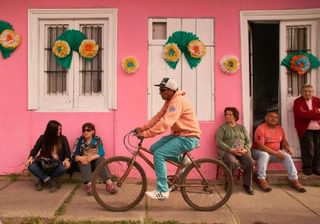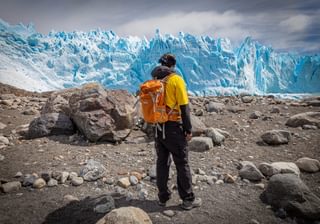Chile Trip Inspiration
Speak to a Chile expert today
Start planning your dream trip to Chile

Amanda
Travel Expert
Chile is an exciting and safe place for LGBTQ+ travellers

Chile has rapidly emerged as a welcoming and vibrant destination for LGBTQ+ travellers seeking safe travel that is, more importantly, fun! In this insightful guide, Melissa Morales Madariaga, a journalist from Santiago, takes us on a personal journey through Chile's remarkable progress on LGBTQ+ issues. Melissa shares her experiences growing up in a changing society and illustrates why this South American gem will capture your heart.
Chile offers a unique blend of cultural richness and breathtaking landscapes. Whether you're looking to explore the vibrant streets of Santiago, unwind in world-class wineries, or trek through the awe-inspiring Patagonian wilderness, Melissa's perspective provides valuable insights for LGBTQ+ travellers and allies alike. This guide will take you through Chile's journey towards equality, highlight its LGBTQ+-friendly hotspots, and showcase the diverse array of experiences awaiting you. Read to discover why Chile has become a must-visit destination for the LGBTQ+ community.


Chile celebrated the legalisation of same-sex marriage with a reception at La Moneda Palace, hosted by President Gabriel Boric. The law, effective since March 10, 2022, reflects the wishes of nearly 83% of same-sex couples in Chile.
The Equal Marriage Law was published on December 10, 2021, on Human Rights Day. This made Chile the 7th Latin American and 32nd country globally to recognise same-sex marriage. The law updated the Civil Code, replacing terms like ‘husband’ and ‘wife’ with ‘spouses’, and ‘father’ and ‘mother’ with ‘parents’. It addresses adoption, children’s legal status, labour rights, and non-discrimination based on sexual orientation or gender identity. It also removed a clause annulling marriages if a person changed gender; now, marriage and divorce depend solely on the consent of both parties.

Since then, over 5,000 couples have gotten married, including Nicole (31) and Fernanda (30), who tied the knot in December 2023 after four years together. They met at Chueca Bar in Santiago on Saint Valentines and got engaged in April 2023. But being openly lesbian wasn’t always easy for them, or for me. When Nicole and I met in 2006, we were both from very conservative environments and were among the first queer people each other had ever encountered. Society was not as accepting as it is now, and coming out was a hard and slow process, but during our university years, we saw spaces being created for the LGBTQ+ community. "I feel like Chile is definitely more open than it used to be 15 years ago. Nowadays, you see couples holding hands all the time, even in small cities, not just Santiago" reflects Nicole.


Chile’s journey towards equality has been gradual. Legal divorce was only recognised in 2004, and abortion was completely banned until 2017 when it was allowed under restrictive conditions. Same-sex partnerships were acknowledged in 2015 with civil unions, which offered limited protections compared to marriage.

The 2021 Equal Marriage Law follows the Gender Identity Law of 2018 and represents a significant move towards further legislative and social changes aimed at achieving true equality for all. The Gender Identity Law allows individuals over the age of 14 to change their name and gender on official documents without the need for medical or psychological evaluations. For adults, the process is straightforward after asking the Civil Registry, while minors require judicial authorisation and parental consent. This law strengthens anti-discrimination protections and empowers transgender people to live according to their true gender identity, marking a significant step towards greater inclusion and respect for LGBTQ+ rights in Chile.

The Zamudio Law, or Anti-Discrimination Law, was enacted in 2012 following the murder of Daniel Zamudio, a young gay man. This law addresses discrimination based on sexual orientation and gender identity, among other factors. Despite enforcement challenges, it has significantly influenced public opinion and societal attitudes toward LGBTQ+ people.

As a teenager, I would worry a lot about what people would think of me. It was more of a taboo back then, and I didn't always have the support of my friends and family. Being homosexual was frowned upon and to be hidden. Today, I do have that support, after a long process where we all realised it was a rather silly concern.
In my late twenties, I had a known partner that I never had to hide. This isn’t something my father, Sergio (65), can say, as he had to grow up in a much more conservative society and environment, marry a woman, and build a conventional family.
Today, he's married to Jorge, and everyone knows, but it wasn't always that way. They have been together for 19 years, with the first years being a ‘secret’ relationship. When the Civil Union Agreement came out, I asked, “Dad, are you gonna do it?”, “I don’t know, I haven't thought about it”. “But you have been together 11 years already…”.
They did it, threw a big party, and five years later, when same-sex marriage became legal, they got married.


While laws alone cannot completely change societal views, the Zamudio Law has sparked important public discussions about discrimination and equality. The visibility of this legislation has contributed to raising awareness about the struggles faced by the LGBTQ+ community and has helped foster a more accepting and inclusive environment. It has encouraged people to question prejudices and has provided a legal framework for those who face discrimination to seek justice.
The implementation of the Zamudio Law, along with other progressive legal changes, has played a part in the gradual shift in public perception. It has helped embed the notion of equality in the collective mindset, promoting a culture of acceptance and respect. This cultural shift is reflected in the increasing support for same-sex marriage and adoption rights, as well as the growing visibility and acceptance of LGBTQ+ people in various aspects of Chilean society.
As a primary school teacher, Nicole emphasises the growing visibility of LGBTQ+ parenting, noting that "this didn’t happen eight years ago." Still, now she has all kinds of families and parents as her students' guardians.


In 2009, only 33.2% of Chileans supported same-sex marriage, while 65.2% opposed it. Support among young people (15-29) was higher at 56%. By 2011, 52% of Chileans favoured legal rights for same-sex unions, though only 27% supported marriage.
By 2012 this was beginning to change, with 54.9% supporting same-sex marriage, increasing to 55% by 2014, and 60% by 2015, reaching 61% in 2016. Among younger generations, support was even stronger; in 2018, 79% of middle school students were in favour.
By 2022, overall support had surged to 82%, with 70% backing adoption rights for same-sex couples. This significant increase in support over the years reflects Chile's evolving social attitudes and growing acceptance of LGBTQ+ rights, contributing to a safer and more inclusive environment for the community.
Now, Chile can offer a welcoming and vibrant environment for LGBTQ+ people. The capital, Santiago, boasts a lively gay scene with numerous bars, clubs, and cafes that cater to the community. Annual Pride Parades attract large crowds, showcasing the strength and visibility of LGBTQ+ activism and support.

“My wife and I feel safe here in Chile; I think it is the safest in Latin America. We can be affectionate in public spaces without the fear that something bad might happen” says Nicole. “We do live in a safe area. Ñuñoa is known for being a very open and progressive neighbourhood.” PDA must be evaluated in advance in smaller towns or rural areas as they might attract unwanted attention, but overall, in Santiago, it is very common among same-sex couples.
Next to Ñuñoa, you have neighborhoods like Providencia and Bellavista where you can find a lot of gay things going on. Chueca bar opened a couple of years ago as the first lesbian and feminist bar in the city, with local craft beers owned and produced by queer women, traditional sharing-sized Chilean dishes with vegan options, signature cocktails, and edgy decoration.
There is a party called “Realidad Paralela”, which is a clever use of wordplay. The name can be interpreted as 'parallel reality,' but it also plays on the words “realidad para lela”, with “lela” being a colloquial term for lesbian in Chile. So, it simultaneously means 'reality for lesbians' and “parallel reality”, highlighting a fun and inclusive theme for the event. It is celebrated in different locations and appears to be a safe and fun alternative to historically gay clubs - mostly male-oriented - with an amazing vibe, featuring live DJs and urban genre music.
Contra Mano is an LGBTQ+ resto-club located on Bombero Núñez street, the epicentre of queer activity in the Bellavista neighbourhood, with different shows that include comedy, theatre, drag performances, and cabaret burlesque.

Organisations like MOVILH and Fundación Iguales are pivotal in advocating for LGBTQ+ rights and providing resources and support. MOVILH, established in 1991, focuses on promoting the rights and dignity of the community through legal action, public campaigns, and education. They document human rights abuses and lobby for legal protections and social acceptance. Fundación Iguales, founded in 2011, works on legal advocacy, public policy, and social change initiatives. They have been instrumental in advancing significant legislative changes, such as the Gender Identity Law and the Equal Marriage Law and continue to push for further advancements in equality
Chile's diverse landscapes and rich cultural heritage make it a fantastic destination for all travellers, including the LGBTQ+ community. Here are some highlights and activities across the different regions of Chile:

In the north, the Atacama Desert is a must-visit for its otherworldly landscapes and unparalleled stargazing opportunities. San Pedro de Atacama is the gateway to this region, offering access to some of Chile's most spectacular natural wonders. Visit the Valle de la Luna (Moon Valley) for its dramatic rock formations, explore the salt flats of Salar de Atacama, and witness the geysers in El Tatio.
Another highlight in northern Chile is the Elqui Valley, known for its production of pisco, Chile's iconic brandy-like liquor. The Elqui Valley boasts clear skies and is also a top destination for stargazing. Visit one of the many pisco distilleries, such as Pisquera Mistral, to learn about the distillation process and enjoy tastings. The valley's unique combination of vineyards, desert landscapes, and clear night skies makes it an unforgettable destination.


Where to stay in the Atacama Desert: Tierra Atacama Hotel & Spa, - desert luxury, adventure, and cultural immersion or Nayara Alto Atacama – a luxurious desert hideaway that blends seamlessly into the world’s driest terrain.
Where to stay in Elqui Valley: Casa Molle a beautiful retreat in the stunning Elqui Valley, or Elqui Domos - unique domes in the heart of the Valley.
Barrio Bellavista is renowned for its bohemian atmosphere, colourful street art, and lively nightlife. This neighbourhood is a hub for LGBTQ+ culture, with numerous gay-friendly bars, clubs, and cafes. Iconic spots include ‘Blondie’, one of the largest and most popular LGBTQ+ clubs in Santiago, offering a mix of music, dance, and drag shows.
Lastarria neighbourhood is another must-visit area, known for its artsy vibe and cultural significance. The neighbourhood is packed with trendy restaurants, boutique shops, and historic buildings. You can enjoy a walk through Parque Forestal, visit the Museo de Bellas Artes, or catch an indie film at Cine Arte Alameda.

For a dose of nature, you can head to Santiago Metropolitan Park, one of the largest urban parks in the world. There’s a funicular that takes you up to Cerro San Cristobal for breathtaking views of the city and the Andes Mountains. The park is also home to the beautiful Metropolitan Zoo and several hiking trails.
Where to stay: The Singular Santiago, a stylish hotel in the charming Lastarria neighbourhood, Le Reve for French-inspired elegance and contemporary luxury, or Luciano K, an art deco gem in the heart of the bohemian Lastarria.
What to do: look at more Santiago trip ideas.


Wine lovers should not miss a trip to the Casablanca Valley, one of Chile's premier wine regions. Known for its cool-climate varietals like Sauvignon Blanc and Pinot Noir, the valley offers numerous wineries where you can enjoy bike tours and tastings. If you continue through the valley to the coast, you will find Valparaíso, a UNESCO World Heritage Site known for its colourful hillside houses, vibrant street art, and historic funiculars. The city's labyrinthine streets are perfect for exploring on foot. You can visit the Museo a Cielo Abierto, an open-air museum featuring murals by local artists, and enjoy fresh seafood at the many coastal restaurants.

Where to stay: La Casona Matetic, a charming luxury country home nestled on a thriving wine estate in the Casablanca Valley or Casa Higueras, a stylish boutique hotel in Valparaiso.
What to do: Take a look at Far & Wild’s 13-day Winelands of Chile & Argentina trip.
The Lake District, with its stunning lakes, snow-capped volcanoes, and lush forests, is perfect for outdoor enthusiasts. Cities like Pucón offer a range of activities, from hiking in national parks to relaxing in natural hot springs. Pucón is also a gateway to the Villarrica Volcano, where adventurous travelers can go on guided climbs. The region is known for its beautiful landscapes and opportunities for water sports such as kayaking, rafting, and fishing.
In the southern regions of Chile, the numerous thermal springs, such as the Termas Geométricas and Termas de Chillán, offer a perfect blend of relaxation and adventure. Nestled in the stunning landscapes of the Andes mountains, these hot springs provide a soothing retreat amid natural beauty. Visitors can enjoy soaking in the warm, mineral-rich waters while taking in views of lush forests and volcanic peaks.


Further south, the Patagonia region offers some of the most breathtaking scenery in the world. Torres del Paine National Park, with its iconic mountain peaks, glaciers, and diverse wildlife, is a must-visit for nature lovers. The park offers various trekking routes, including the famous W Circuit, providing unparalleled opportunities to experience the pristine beauty of Patagonia. The park's landscapes include the towering granite spires of the Paine massif, turquoise lakes, and vast ice fields.
Where to stay: Awasi Patagonia - an exclusive escape into the heart of the National Park or Lago Grey - a traditional style lodge by the lake.
What to do: Take a look at Far & Wild’s 12-night trip Classic Chile which encompasses all the highlights

Chile's transformation into an LGBTQ+-friendly destination is a testament to the country's commitment to progress and inclusivity. From the bustling streets of Santiago to the serene beauty of the Atacama Desert, Chile offers a wealth of experiences that cater to all travellers. As you plan your journey to this diverse and welcoming nation, remember that every region has its own unique charm and attractions waiting to be discovered. Whether you're drawn to the wine regions of Central Chile, the outdoor adventures of the Lake District, or the untamed wilderness of Patagonia, there's a Chilean experience tailored just for you. Ready to turn your Chilean dreams into reality?
Explore Far & Wild's range of customisable trips and let our Latin America expert, Amanda, guide you in creating the perfect itinerary that combines Chile's natural wonders with its warm, inclusive culture. Your unforgettable Chilean adventure awaits – start planning today with Far & Wild!
Start planning your dream trip to Chile

Travel Expert